
YOUR TRUSTED PARTNER FOR KEEPING DOGS SAFE
Snake Avoidance Classes
Snake Avoidance Training Page
Welcome to United K9's comprehensive resource on snake bite statistics and avoidance training. Discover the alarming truth about snake bites in the United States. We'll also delve into the financial impact of snake bites. Furthermore, we'll provide invaluable insights into the 15 species of venomous snakes found in Texas, including Copperheads, Cottonmouths, and Rattlesnakes. At United K9, we prioritize the safety and humane handling of venomous snakes, never resorting to defanging or causing harm. If you're interested in learning more about snake bite classes and avoidance training, please fill out our training form below. Your pet's safety is our priority.

150,000
150000 snake bites each year

25%
25% Fatality Rate From Venomous Snake bites

$3000+
Dollars Spent after a Snake Bite

15 Species
There are 15 Species of Venomous Snake in Texas
Pit Vipers
Pit vipers are venomous snakes that have an opening on each side of the head between the eye and the nostril. In Texas, we have three groups of these snakes: Copperheads, Cottonmouths, and Rattlesnakes.

Copperheads (Agkistrodon contortrix):
Copperheads have chestnut or reddish-brown crossbands on a lighter-colored body. These snakes are found in rocky areas and wooded bottomlands and are rare in dry areas. In the spring, they can be found along streams and rivers, as well as in weed-covered vacant lots. There are three subspecies of Copperheads in Texas; Southern copperhead (A.c. contortrix), 20-30 inches long and found in the eastern one-third of the state; Broad Banded copperhead (A.c. laticinctus), about two feet long, widely scattered in central and western Texas; and the Trans-Pecos copperhead (A.c. pictigaster), 20-30 inches in length and found near springs in the southern part of the Trans-Pecos.
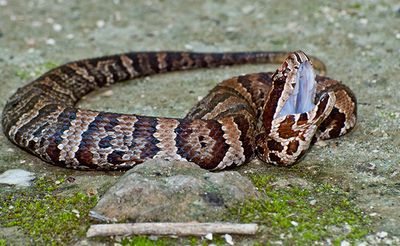
Cottonmouth snake (Agkistrodon piscivorous):
The Latin name piscivorous means 'fish eating,' indicating its dietary characteristics. Also known as 'water moccasins', only one recognized subspecies is found in Texas: Western cottonmouth (A.p. leucostoma). Cottonmouths can be dark brown, olive brown, olive green, or almost solid black. They are marked with wide, dark bands, which are more distinct in some individuals than in others. Juvenile snakes are more brilliantly marked. The cottonmouth gets its name from the white tissue inside its mouth, which it displays when threatened. This heavy-bodied snake, which averages about 3-1/2 feet in length, is found over the eastern half of the state in swamps and sluggish waterways, coastal marshes, rivers, ponds, and streams.

Rattlesnakes:
There are two groups of rattlesnakes. The more primitive forms belong to the genus Sistrurus. Texas has two:
Western massasauga (Sistrurus catenatus tergeminus): Light gray, with brown oval blotches along the middle of the back and smaller blotches along each side. They are two feet in length and found through the middle of the state in grasslands, marshy, and swampy areas.
- Desert massasauga (S.c. edwardsii): Lighter in color than the western massasauga, smaller and more slender. Found in the Trans-Pecos, western Panhandle, and the lower Rio Grande Valley.
Western Diamondback Snake
The more advanced forms of rattlesnakes belong to the genus Crotalus, and Texas is home to seven:
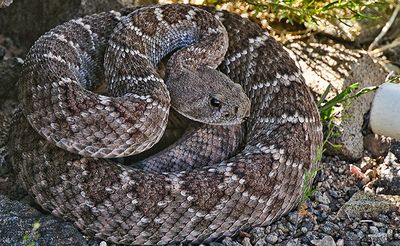
Western diamondback (Crotalus atrox):
Brown, diamond-shaped markings along the middle of the back and alternating black and white rings on the tail. Averages 3 1/2 to 4-1/2 feet in length, and can reach seven feet. This is the most common and widespread venomous snake in Texas, found in all but the easternmost part of the state.
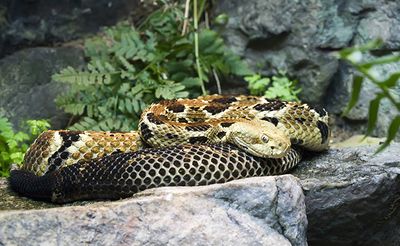
Timber rattlesnake (Crotalus horridus):
Also known as Canebreak rattlesnake is a large, heavy-bodied snake averaging 4-1/2 feet. Brown or tan with wide, dark crossbands. The tail is entirely black. Found in the eastern third of the state in wooded areas in wet bottomlands.
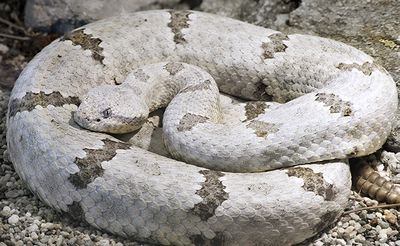
Mottled Rock rattlesnake (Crotalus lepidus):
Light bream or pink background with widely spaced, dark crossbands and mottled areas between the crossbands. Small and slender with an average length of about two feet. Found in the mountainous areas of West Texas.
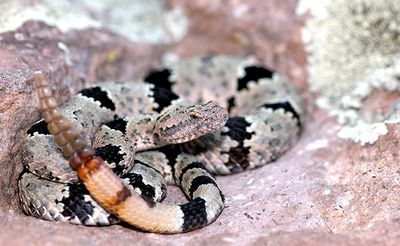
Banded Rock rattlesnake (C.l. klauberi):
Similar to the mottled rock rattlesnake, but darker greenish-gray in color. Found only in the extreme western tip of Texas.
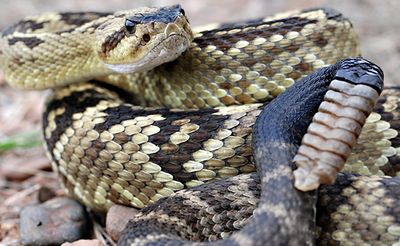
Blacktail rattlesnake (Crotalus molossus):
Gray to olive green with dark blotches along the back and a black tail. Averaging a length of 3-1/2 feet, it is found from Central Texas throughout most of West Texas in bushes and on rocky ledges.
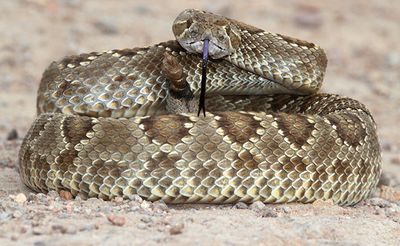
Mojave rattlesnake (Crotalus scutulatus):
Similar to the western diamondback in markings, but smaller and more slender and found only in extreme West Texas.
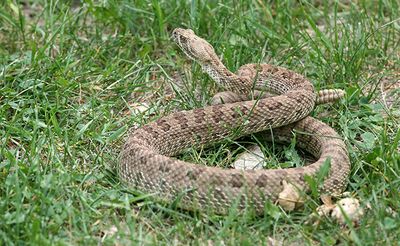
Prairie rattlesnake (Crotalus viridis viridis):
A slender rattler that is greenish or grayish, with rounded blotches down the middle of its back. The average length is about three feet, and it is found in the grassy plains of the western third of the state.
North American Cobras
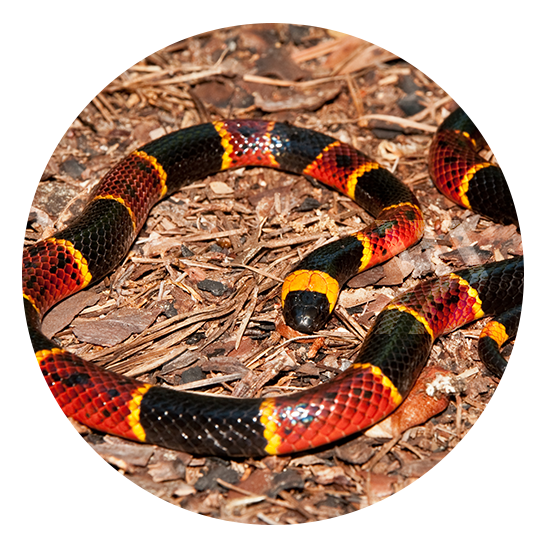
Coral Snake (Micrurus fulvius tener)
The brightly colored Texas coral snake is the state's only member of the Elapidae family, which includes the cobras of Asia and Africa. The coral snake is slender with a small indistinctive head and round pupils, and it usually is 2-1/2 feet or shorter. Its distinctive pattern is a broad black ring, a narrow yellow ring, and a broad red ring, with the red rings always bordered by the yellow rings. Several harmless snakes are similarly marked, but never with the red and yellow touching. Coral snakes are found in the southeastern half of Texas in woodlands, canyons, and coastal plains.
GEt Trained
At United K9 we believe in the safety of all living animals, including Nope Ropes. (Snakes) Therefore all Venomous Snakes will be handled with care and will be displayed in a Clear see-through box. We don't believe that the snake should be defanged or its mouth stapled closed (would kill the snake) Please fill out a training form for more info.
